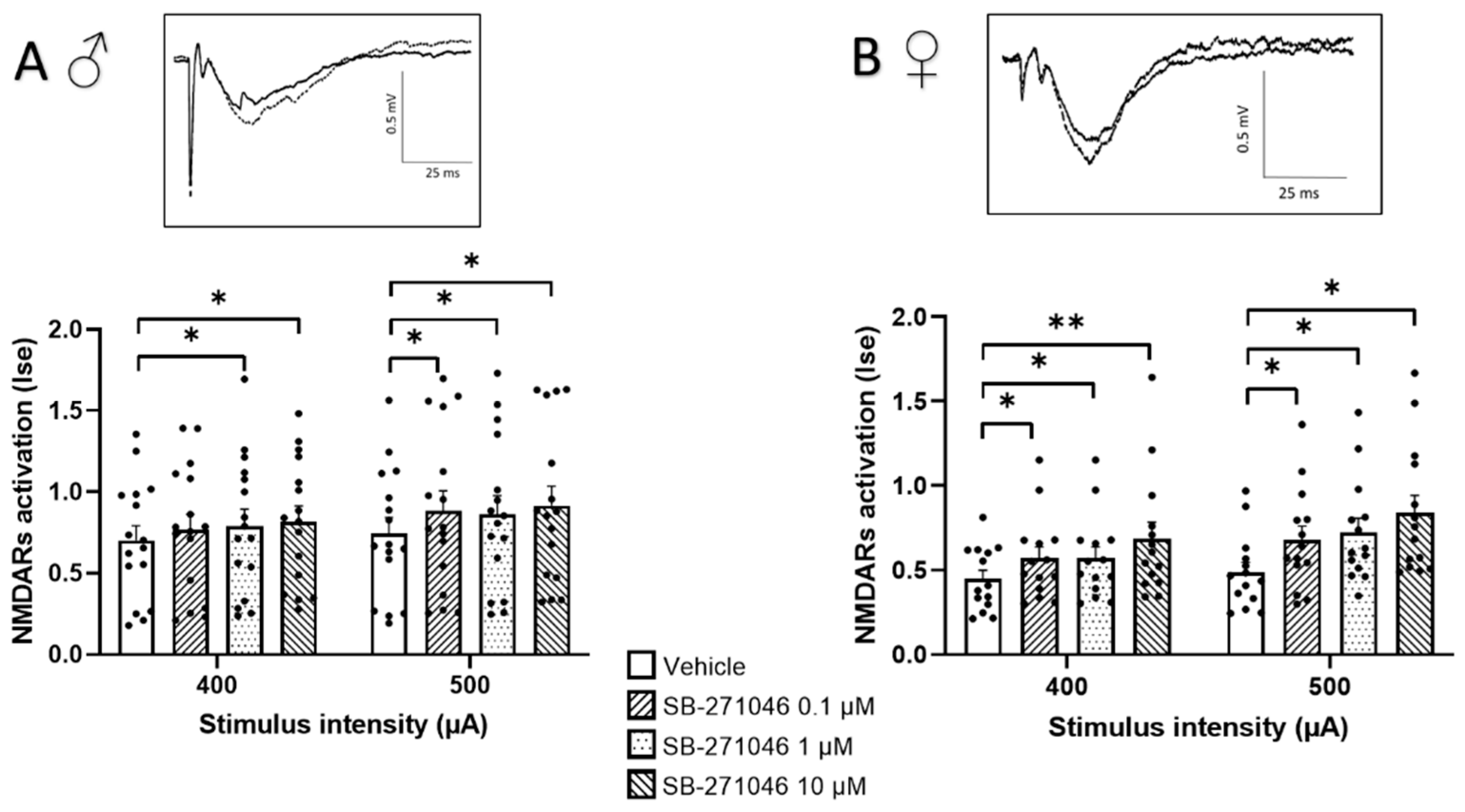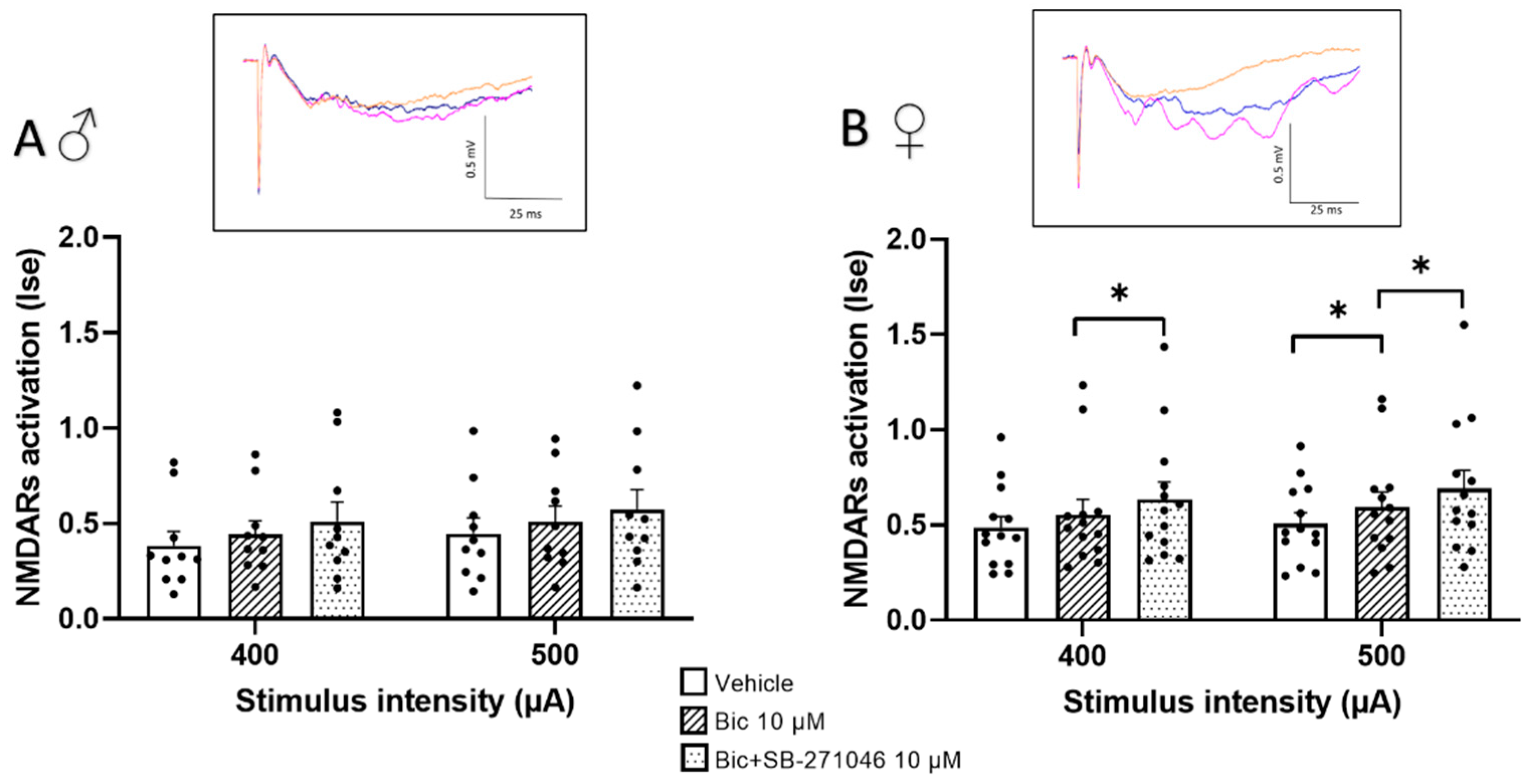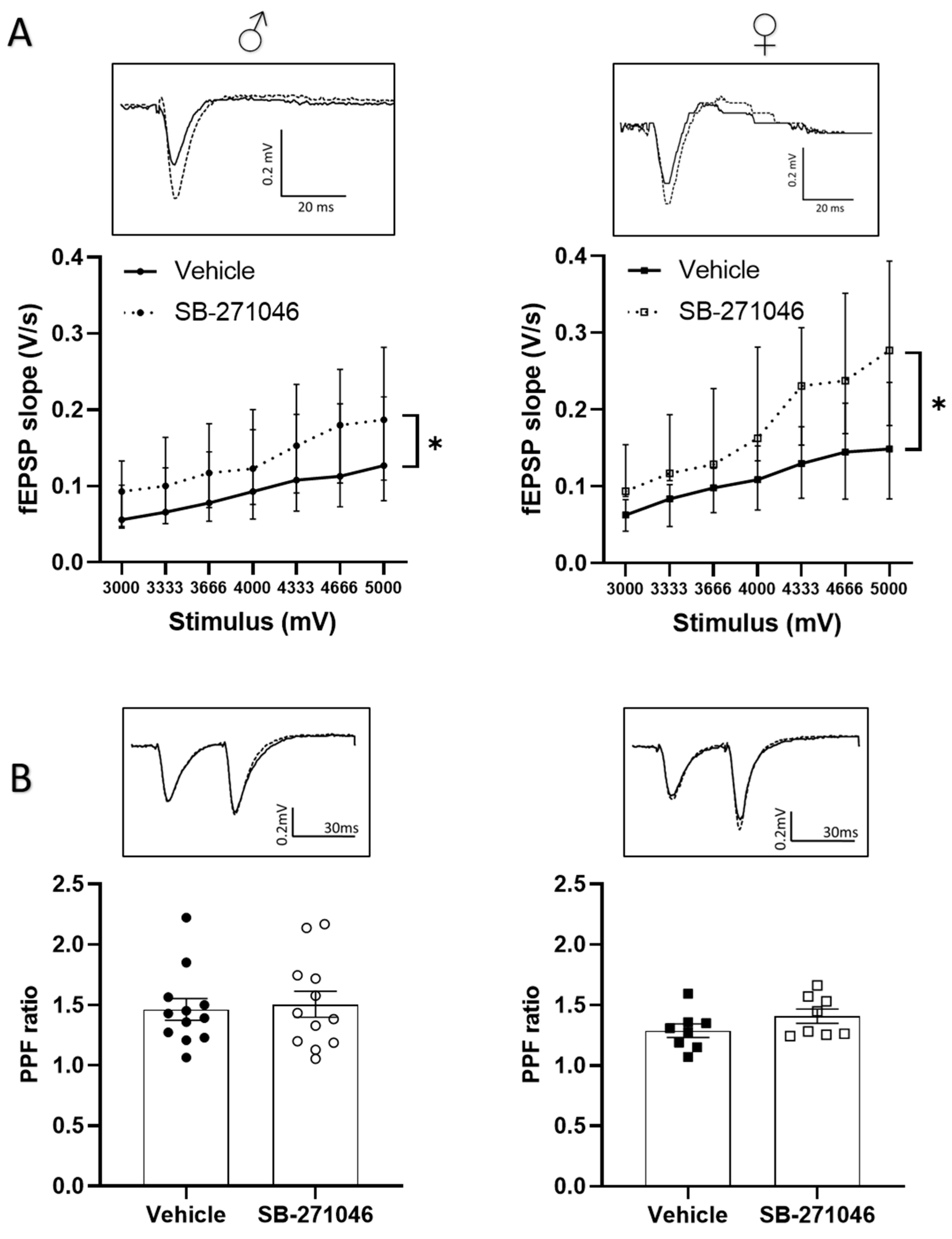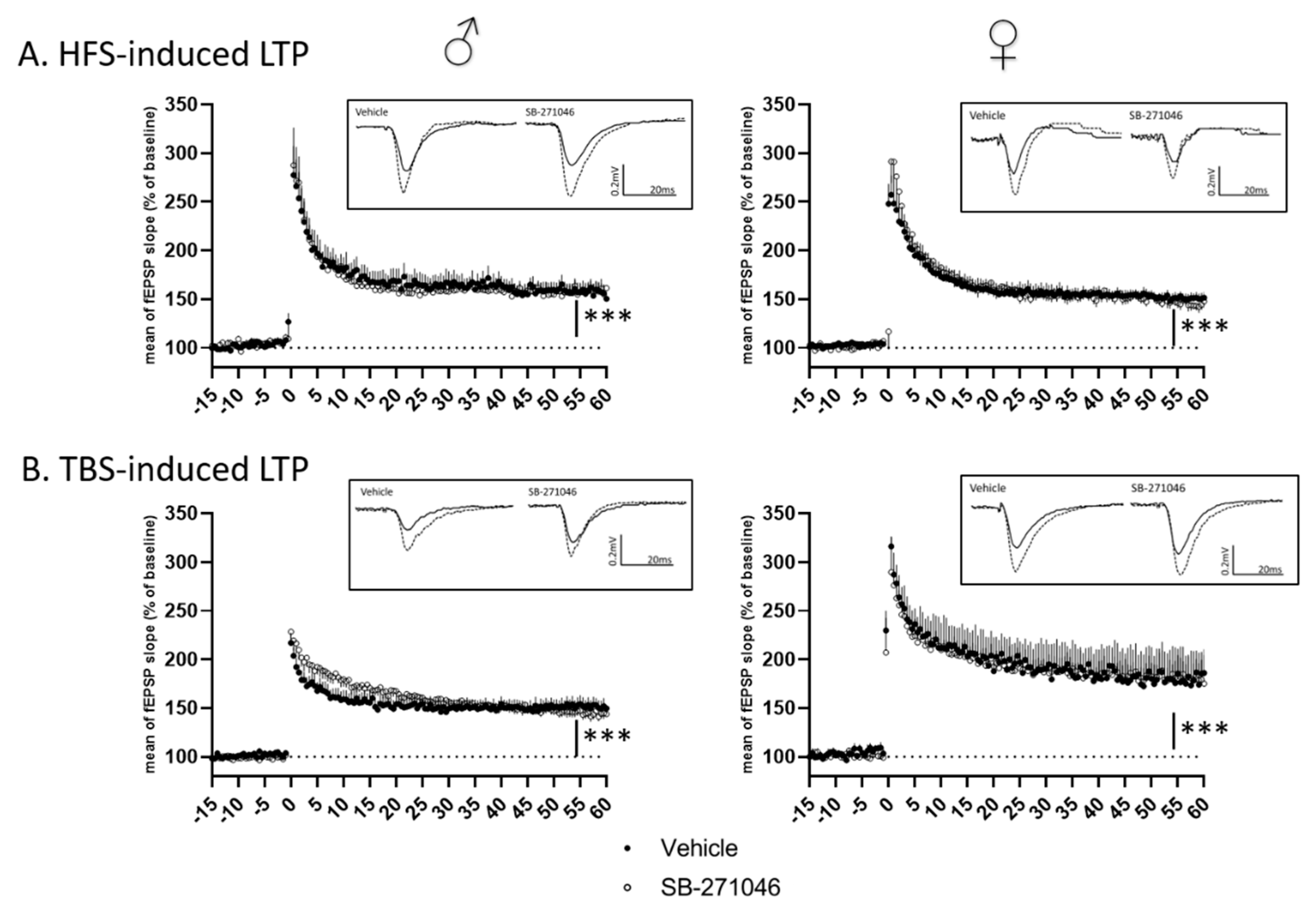5-HT6 Receptors Sex-Dependently Modulate Hippocampal Synaptic Activity through GABA Inhibition
Abstract
1. Introduction
2. Materials and Methods
2.1. Animals
2.2. Pharmacology
2.3. Extracellular Electrophysiology
2.4. Data Analysis
3. Results
3.1. Effects of SB-271046 on NMDARs’ Activation
3.2. Effects of SB-271046 on Basal Synaptic Transmission
3.3. Effects of SB-271046 on Functional Plasticity
4. Discussion
Author Contributions
Funding
Institutional Review Board Statement
Informed Consent Statement
Data Availability Statement
Acknowledgments
Conflicts of Interest
References
- Ruat, M.; Traiffort, E.; Arrang, J.M.; Tardivellacombe, J.; Diaz, J.; Leurs, R.; Schwartz, J.C. A Novel Rat Serotonin (5-HT6) Receptor: Molecular Cloning, Localization and Stimulation of CAMP Accumulation. Biochem. Biophys. Res. Commun. 1993, 193, 268–276. [Google Scholar] [CrossRef] [PubMed]
- Kohen, R.; Metcalf, M.A.; Khan, N.; Druck, T.; Huebner, K.; Lachowicz, J.E.; Meltzer, H.Y.; Sibley, D.R.; Roth, B.L.; Hamblin, M.W. Cloning, Characterization, and Chromosomal Localization of a Human 5-HT6 Serotonin Receptor. J. Neurochem. 1996, 66, 47–56. [Google Scholar] [CrossRef] [PubMed]
- Woolley, M.L.; Marsden, C.A.; Fone, K.C.F. 5-Ht6 Receptors. Curr. Drug Targets CNS Neurol. Disord. 2004, 3, 59–79. [Google Scholar] [CrossRef] [PubMed]
- Bromidge, S.M.; Brown, A.M.; Clarke, S.E.; Dodgson, K.; Gager, T.; Grassam, H.L.; Jeffrey, P.M.; Joiner, G.F.; King, F.D.; Middlemiss, D.N.; et al. 5-Chloro-N-(4-Methoxy-3-Piperazin-1-Yl-Phenyl)-3-Methyl-2- Benzothiophenesulfonamide (SB-271046): A Potent, Selective, and Orally Bioavailable 5-HT6 Receptor Antagonist. J. Med. Chem. 1999, 42, 202–205. [Google Scholar] [CrossRef]
- Routledge, C.; Bromidge, S.M.; Moss, S.F.; Price, G.W.; Hirst, W.; Newman, H.; Riley, G.; Gager, T.; Stean, T.; Upton, N.; et al. Characterization of SB-271046: A Potent, Selective and Orally Active 5-HT6 Receptor Antagonist. Br. J. Pharmacol. 2000, 130, 1606–1612. [Google Scholar] [CrossRef] [PubMed]
- Roth, B.L.; Craigo, S.C.; Choudhary, M.S.; Uluer, A.; Monsma, F.J.; Shen, Y.; Meltzer, H.Y.; Sibley, D.R. Binding of Typical and Atypical Antipsychotic Agents to 5- Hydroxytryptamine-6 and 5-Hydroxytryptamine-7 Receptors. J. Pharmacol. Exp. Ther. 1994, 268, 1403–1410. [Google Scholar]
- Monsma, F.J.; Shen, Y.; Ward, R.P.; Hamblin, M.W.; Sibley, D.R. Cloning and Expression of a Novel Serotonin Receptor with High Affinity for Tricyclic Psychotropic Drugs. Mol. Pharmacol. 1993, 43, 320–327. [Google Scholar]
- Glatt, C.E.; Snowman, A.M.; Sibley, D.R.; Snyder, S.H. Clozapine: Selective Labeling of Sites Resembling 5HT6 Serotonin Receptors May Reflect Psychoactive Profile. Mol. Med. 1995, 1, 398–406. [Google Scholar] [CrossRef]
- Mørk, A.; Witten, L.M.; Arnt, J. Effect of Sertindole on Extracellular Dopamine, Acetylcholine, and Glutamate in the Medial Prefrontal Cortex of Conscious Rats: A Comparison with Risperidone and Exploration of Mechanisms Involved. Psychopharmacology 2009, 206, 39–49. [Google Scholar] [CrossRef]
- Correll, C.U.; Howes, O.D. Treatment-Resistant Schizophernia. J. Clin. Psychiatry 2021, 82, MY20096AH1C. [Google Scholar] [CrossRef]
- Shimizu, S.; Mizuguchi, Y.; Ohno, Y. Improving the Treatment of Schizophrenia: Role of 5-HT Receptors in Modulating Cognitive and Extrapyramidal Motor Functions. CNS Neurol. Disord. Drug Targets 2013, 12, 861–869. [Google Scholar] [CrossRef] [PubMed]
- Nirogi, R.; Jayarajan, P.; Shinde, A.; Mohammed, A.R.; Grandhi, V.R.; Benade, V.; Goyal, V.K.; Abraham, R.; Jasti, V.; Cummings, J. Progress in Investigational Agents Targeting Serotonin-6 Receptors for the Treatment of Brain Disorders. Biomolecules 2023, 13, 309. [Google Scholar] [CrossRef]
- Rosse, G.; Schaffhauser, H. 5-HT6 Receptor Antagonists as Potential Therapeutics for Cognitive Impairment. Curr. Top. Med. Chem. 2010, 10, 207–221. [Google Scholar] [CrossRef] [PubMed]
- De Bruin, N.; Kruse, C. 5-HT6 Receptor Antagonists: Potential Efficacy for the Treatment of Cognitive Impairment in Schizophrenia. Curr. Pharm. Des. 2015, 21, 3739–3759. [Google Scholar] [CrossRef] [PubMed]
- Da Silva Costa-Aze, V.; Quiedeville, A.; Boulouard, M.; Dauphin, F. 5-HT6 Receptor Blockade Differentially Affects Scopolamine-Induced Deficits of Working Memory, Recognition Memory and Aversive Learning in Mice. Psychopharmacology 2012, 222, 99–115. [Google Scholar] [CrossRef]
- Foley, A.G.; Murphy, K.J.; Hirst, W.D.; Gallagher, H.C.; Hagan, J.J.; Upton, N.; Walsh, F.S.; Regan, C.M. The 5-HT6 Receptor Antagonist SB-271046 Reverses Scopolamine-Disrupted Consolidation of a Passive Avoidance Task and Ameliorates Spatial Task Deficits in Aged Rats. Neuropsychopharmacology 2004, 29, 93–100. [Google Scholar] [CrossRef]
- Loiseau, F.; Dekeyne, A.; Millan, M.J. Pro-Cognitive Effects of 5-HT6 Receptor Antagonists in the Social Recognition Procedure in Rats: Implication of the Frontal Cortex. Psychopharmacology 2008, 196, 93–104. [Google Scholar] [CrossRef]
- Kendall, I.; Slotten, H.A.; Codony, X.; Burgueño, J.; Pauwels, P.J.; Vela, J.M.; Fone, K.C.F. E-6801, a 5-HT6 Receptor Agonist, Improves Recognition Memory by Combined Modulation of Cholinergic and Glutamatergic Neurotransmission in the Rat. Psychopharmacology 2011, 213, 413–430. [Google Scholar] [CrossRef]
- Da Silva Costa-Aze, V.; Dauphin, F.; Boulouard, M. Serotonin 5-HT6 Receptor Blockade Reverses the Age-Related Deficits of Recognition Memory and Working Memory in Mice. Behav. Brain Res. 2011, 222, 134–140. [Google Scholar] [CrossRef]
- King, M.V.; Marsden, C.A.; Fone, K.C.F. A Role for the 5-HT1A, 5-HT4 and 5-HT6 Receptors in Learning and Memory. Trends Pharmacol. Sci. 2008, 29, 482–492. [Google Scholar] [CrossRef]
- Marcos, B.; Chuang, T.T.; Gil-Bea, F.J.; Ramirez, M.J. Effects of 5-HT 6 Receptor Antagonism and Cholinesterase Inhibition in Models of Cognitive Impairment in the Rat. Br. J. Pharmacol. 2008, 155, 434–440. [Google Scholar] [CrossRef] [PubMed]
- Quiedeville, A.; Boulouard, M.; Hamidouche, K.; Da Silva Costa-Aze, V.; Nee, G.; Rochais, C.; Dallemagne, P.; Fabis, F.; Freret, T.; Bouet, V. Chronic Activation of 5-HT4 Receptors or Blockade of 5-HT6 Receptors Improve Memory Performances. Behav. Brain Res. 2015, 293, 10–17. [Google Scholar] [CrossRef] [PubMed]
- Amodeo, D.A.; Peterson, S.; Pahua, A.; Posadas, R.; Hernandez, A.; Hefner, E.; Qi, D.; Vega, J. 5-HT6 Receptor Agonist EMD386088 Impairs Behavioral Flexibility and Working Memory. Behav. Brain Res. 2018, 349, 8–15. [Google Scholar] [CrossRef]
- Suárez-Santiago, J.E.; Roldán Roldán, G.; Picazo Picazo, O. The 5-HT6R Agonist E-6837 and the Antagonist SB-271046 Reverse the Psychotic-like Behaviors Induced by Ketamine. Behav. Pharmacol. 2022, 33, 249–254. [Google Scholar] [CrossRef] [PubMed]
- Sun, Z.; Wang, B.; Chen, C.; Li, C.; Zhang, Y. 5-HT6R Null Mutatrion Induces Synaptic and Cognitive Defects. Aging Cell 2021, 20, e13369. [Google Scholar] [CrossRef] [PubMed]
- Hirst, W.D.; Stean, T.O.; Rogers, D.C.; Sunter, D.; Pugh, P.; Moss, S.F.; Bromidge, S.M.; Riley, G.; Smith, D.R.; Bartlett, S.; et al. SB-399885 Is a Potent, Selective 5-HT6 Receptor Antagonist with Cognitive Enhancing Properties in Aged Rat Water Maze and Novel Object Recognition Models. Eur. J. Pharmacol. 2006, 553, 109–119. [Google Scholar] [CrossRef]
- Asselot, R.; Simon-O’Brien, E.; Lebourgeois, S.; Nee, G.; Delaunay, V.; Duchatelle, P.; Bouet, V.; Dauphin, F. Time-Dependent Impact of Glutamatergic Modulators on the Promnesiant Effect of 5-HT6R Blockade on Mice Recognition Memory. Pharmacol. Res. 2017, 118, 111–118. [Google Scholar] [CrossRef] [PubMed]
- Lacroix, L.P.; Dawson, L.A.; Hagan, J.J.; Heidbreder, C.A. 5-HT6 Receptor Antagonist SB-271046 Enhances Extracellular Levels of Monoamines in the Rat Medial Prefrontal Cortex. Synapse 2004, 51, 158–164. [Google Scholar] [CrossRef]
- Dawson, L.A.; Nguyen, H.Q.; Li, P. In Vivo Effects of the 5-HT6 Antagonist SB-271046 on Striatal and Frontal Cortex Extracellular Concentrations of Noradrenaline, Dopamine, 5-HT, Glutamate and Aspartate. Br. J. Pharmacol. 2000, 130, 23–26. [Google Scholar] [CrossRef]
- Dawson, L.A.; Nguyen, H.Q.; Li, P. The 5-HT6 Receptor Antagonist SB-271046 Selectively Enhances Excitatory Neurotransmission in the Rat Frontal Cortex and Hippocampus. Neuropsychopharmacology 2001, 25, 662–668. [Google Scholar] [CrossRef]
- Dawson, L.A.; Li, P. Effects of 5-HT6 Receptor Blockade on the Neurochemical Outcome of Antidepressant Treatment in the Frontal Cortex of the Rat. J. Neural Transm. 2003, 110, 577–590. [Google Scholar] [CrossRef] [PubMed]
- Schechter, L.E.; Lin, Q.; Smith, D.L.; Zhang, G.; Shan, Q.; Platt, B.; Brandt, M.R.; Dawson, L.A.; Cole, D.; Bernotas, R.; et al. Neuropharmacological Profile of Novel and Selective 5-HT6 Receptor Agonists: WAY-181187 and WAY-208466. Neuropsychopharmacology 2008, 33, 1323–1335. [Google Scholar] [CrossRef] [PubMed]
- Helboe, L.; Egebjerg, J.; de Jong, I.E.M. Distribution of Serotonin Receptor 5-HT6 MRNA in Rat Neuronal Subpopulations: A Double in Situ Hybridization Study. Neuroscience 2015, 310, 442–454. [Google Scholar] [CrossRef] [PubMed]
- Chaumont-Dubel, S.; Dupuy, V.; Bockaert, J.; Bécamel, C.; Marin, P. The 5-HT6 Receptor Interactome: New Insight in Receptor Signaling and Its Impact on Brain Physiology and Pathologies. Neuropharmacology 2020, 172, 107839. [Google Scholar] [CrossRef] [PubMed]
- Dupuy, V.; Prieur, M.; Pizzoccaro, A.; Margarido, C.; Valjent, E.; Bockaert, J.; Bouschet, T.; Marin, P.; Chaumont-Dubel, S. Spatiotemporal Dynamics of 5-HT6 Receptor Ciliary Localization during Mouse Brain Development. Neurobiol. Dis. 2023, 176, 105949. [Google Scholar] [CrossRef] [PubMed]
- Chaumont-Dubel, S.; Galant, S.; Prieur, M.; Bouschet, T.; Bockaert, J.; Marin, P. Impact of 5-HT6 Receptor Subcellular Localization on Its Signaling and Its Pathophysiological Roles. Cells 2023, 12, 426. [Google Scholar] [CrossRef]
- Morris, R.G.; Davis, S.; Butcher, S.P. Hippocampal Synaptic Plasticity and NMDA Receptors: A Role in Information Storage? Philos. Trans. R. Soc. Lond. B Biol. Sci. 1990, 329, 187–204. [Google Scholar] [CrossRef]
- Bliss, T.V.P.; Collingridge, G.L. A Synaptic Model of Memory: LTP in the Hippocampus. Nature 1993, 361, 31–39. [Google Scholar] [CrossRef]
- Izquierdo, I.; Medina, J.H. Correlation between the Pharmacology of Long-Term Potentiation and the Pharmacology of Memory. Neurobiol. Learn. Mem. 1995, 63, 19–32. [Google Scholar] [CrossRef]
- Lisman, J.E.; McIntyre, C.C. Synaptic Plasticity: A Molecular Memory Switch. Curr. Biol. 2001, 11, 788–791. [Google Scholar] [CrossRef]
- Kim, S.J.; Linden, D.J. Ubiquitous Plasticity and Memory Storage. Neuron 2007, 56, 582–592. [Google Scholar] [CrossRef]
- West, P.J.; Marcy, V.R.; Marino, M.J.; Schaffhauser, H. Activation of the 5-HT6 Receptor Attenuates Long-Term Potentiation and Facilitates GABAergic Neurotransmission in Rat Hippocampus. Neuroscience 2009, 164, 692–701. [Google Scholar] [CrossRef]
- Ivan, S.; Daniela, O.; Jaroslava, B.D. Sex Differences Matter: Males and Females Are Equal but Not the Same. Physiol. Behav. 2023, 259, 114038. [Google Scholar] [CrossRef]
- Abel, K.M.; Drake, R.; Goldstein, J.M. Sex Differences in Schizophrenia. Int. Rev. Psychiatry 2010, 22, 417–428. [Google Scholar] [CrossRef]
- Leger, M.; Neill, J.C. A Systematic Review Comparing Sex Differences in Cognitive Function in Schizophrenia and in Rodent Models for Schizophrenia, Implications for Improved Therapeutic Strategies. Neurosci. Biobehav. Rev. 2016, 68, 979–1000. [Google Scholar] [CrossRef] [PubMed]
- Mendrek, A.; Mancini-Marïe, A. Sex/Gender Differences in the Brain and Cognition in Schizophrenia. Neurosci. Biobehav. Rev. 2016, 67, 57–78. [Google Scholar] [CrossRef]
- Crawford, M.B.; DeLisi, L.E. Issues Related to Sex Differences in Antipsychotic Treatment. Curr. Opin. Psychiatry 2016, 29, 211–217. [Google Scholar] [CrossRef] [PubMed]
- Rabinowitz, J.; Werbeloff, N.; Caers, I.; Mandel, F.S.; Stauffer, V.; Ménard, F.; Kinon, B.J.; Kapur, S. Determinants of Antipsychotic Response in Schizophrenia. J. Clin. Psychiatry 2014, 75, e308–e316. [Google Scholar] [CrossRef]
- Morozova, M.; Burminskiy, D.; Rupchev, G.; Lepilkina, T.; Potanin, S.; Beniashvili, A.; Lavrovsky, Y.; Vostokova, N.; Ivaschenko, A. 5-HT6 Receptor Antagonist as an Adjunct Treatment Targeting Residual Symptoms in Patients with Schizophrenia: Unexpected Sex-Related Effects (Double-Blind Placebo-Controlled Trial). J. Clin. Psychopharmacol. 2017, 37, 169–175. [Google Scholar] [CrossRef] [PubMed]
- Anderson, W.W.; Collingridge, G.L. The LTP Program: A Data Acquisition Program for on-Line Analysis of Long-Term Potentiation and Other Synaptic Events. J. Neurosci. Methods 2001, 108, 71–83. [Google Scholar] [CrossRef]
- Anderson, W.W.; Collingridge, G.L. Capabilities of the WinLTP Data Acquisition Program Extending beyond Basic LTP Experimental Functions. J. Neurosci. Methods 2007, 162, 346–356. [Google Scholar] [CrossRef] [PubMed]
- Mitchell, E.S.; Neumaier, J.F. 5-HT6 Receptors: A Novel Target for Cognitive Enhancement. Pharmacol. Ther. 2005, 108, 320–333. [Google Scholar] [CrossRef] [PubMed]
- Doleviczényi, Z.; Vizi, E.S.; Gacsályi, I.; Pallagi, K.; Volk, B.; Hársing, L.G.; Halmos, G.; Lendvai, B.; Zelles, T. 5-HT6/7 Receptor Antagonists Facilitate Dopamine Release in the Cochlea via a GABAergic Disinhibitory Mechanism. Neurochem. Res. 2008, 33, 2364–2372. [Google Scholar] [CrossRef] [PubMed]
- Creager, B.Y.R.; Dunwiddiet, T.; Lynch, G. Paired-Pulse and Frequency Facilitation in the Cai Region. Physiol. Soc. 1980, 299, 409–424. [Google Scholar]
- Wigström, H.; Gustafsson, B. Two Types of Synaptic Facilitation Recorded in Pyramidal Cells of in Vitro Hippocampal Slices from Guinea Pigs. Neurosci. Lett. 1981, 26, 73–78. [Google Scholar] [CrossRef]
- Gérard, C.; Martres, M.P.; Lefèvre, K.; Miquel, M.C.; Vergé, D.; Lanfumey, L.; Doucet, E.; Hamon, M.; El Mestikawy, S. Immune-Localization of Serotonin 5-HT6 Receptor-like Material in the Rat Central Nervous System. Brain Res. 1997, 746, 207–219. [Google Scholar] [CrossRef]
- Miguel-Hidalgo, J.J. SB-271046 (SmithKline Beecham). Curr. Opin. Investig. Drugs 2001, 2, 118–122. [Google Scholar]
- Rogers, D.C.; Hagan, J.J. 5-HT6 Receptor Antagonists Enhance Retention of a Water Maze Task in the Rat. Psychopharmacology 2001, 158, 114–119. [Google Scholar] [CrossRef]
- King, M.V.; Sleight, A.J.; Woolley, M.L.; Topham, I.A.; Marsden, C.A.; Fone, K.C.F. 5-HT6 Receptor Antagonists Reverse Delay-Dependent Deficits in Novel Object Discrimination by Enhancing Consolidation—An Effect Sensitive to NMDA Receptor Antagonism. Neuropharmacology 2004, 47, 195–204. [Google Scholar] [CrossRef]
- Tassone, A.; Madeo, G.; Sciamanna, G.; Pisani, A.; Bonsi, P. Electrophysiology of 5-HT6 Receptors; Elsevier Inc.: Amsterdam, The Netherlands, 2010; Volume 94, ISBN 9780123849762. [Google Scholar]
- Marrocco, J.; McEwen, B.S. Sex in the Brain: Hormones and Sex Differences. Dialogues Clin. Neurosci. 2016, 18, 373–383. [Google Scholar] [CrossRef]
- Bauer, G.R. Sex and Gender Multidimensionality in Epidemiologic Research. Am. J. Epidemiol. 2022, 192, 122–132. [Google Scholar] [CrossRef]
- Meoni, S.; Macerollo, A.; Moro, E. Sex Differences in Movement Disorders. Nat. Rev. Neurol. 2020, 16, 84–96. [Google Scholar] [CrossRef] [PubMed]
- Mauvais-Jarvis, F.; Bairey Merz, N.; Barnes, P.J.; Brinton, R.D.; Carrero, J.-J.; DeMeo, D.L.; De Vries, G.J.; Epperson, C.N.; Govindan, R.; Klein, S.L.; et al. Sex and Gender: Modifiers of Health, Disease, and Medicine. Lancet 2020, 396, 565–582. [Google Scholar] [CrossRef]
- Zalewska, T.; Pawelec, P.; Ziabska, K.; Ziemka-Nalecz, M. Sexual Dimorphism in Neurodegenerative Diseases and in Brain Ischemia. Biomolecules 2023, 13, 26. [Google Scholar] [CrossRef] [PubMed]
- Pillerová, M.; Pastorek, M.; Borbélyová, V.; Riljak, V.; Frick, K.M.; Hodosy, J.; Tóthová, L. Sex Steroid Hormones in Depressive Disorders as a Basis for New Potential Treatment Strategies. Physiol. Res. 2022, 71, S187–S202. [Google Scholar] [CrossRef] [PubMed]
- Seeman, M.V. Men and Women Respond Differently to Antipsychotic Drugs. Neuropharmacology 2020, 163, 107631. [Google Scholar] [CrossRef]
- Bouet, V.; Percelay, S.; Leroux, E.; Diarra, B.; Léger, M.; Delcroix, N.; Andrieux, A.; Dollfus, S.; Freret, T.; Boulouard, M. A New 3-Hit Mouse Model of Schizophrenia Built on Genetic, Early and Late Factors. Schizophr. Res. 2021, 228, 519–528. [Google Scholar] [CrossRef] [PubMed]
- Kekesi, G.; Petrovszki, Z.; Benedek, G.; Horvath, G. Sex-Specific Alterations in Behavioral and Cognitive Functions in a “Three Hit” Animal Model of Schizophrenia. Behav. Brain Res. 2015, 284, 85–93. [Google Scholar] [CrossRef]




| HFS | TBS | ||||
|---|---|---|---|---|---|
| STP | LTP | STP | LTP | ||
| Male | Vehicle | 180.6 ± 13.35% | 158.2 ± 8.45% | 160.5 ± 8.97% | 180.1 ± 17.67% |
| SB-271046 | 174.5 ± 8.56% | 157.6 ± 8.13% | 177.0 ± 6.91% | 181.2 ± 28.48% | |
| Female | Vehicle | 166.6 ± 6.50% | 148.0 ± 2.87% | 216.8 ± 5.62% | 151.1 ± 7.62% |
| SB-271046 | 181.7.5 ± 8.85% | 148.5 ± 4.44% | 211.7 ± 28.76% | 146.2 ± 4.48% | |
Disclaimer/Publisher’s Note: The statements, opinions and data contained in all publications are solely those of the individual author(s) and contributor(s) and not of MDPI and/or the editor(s). MDPI and/or the editor(s) disclaim responsibility for any injury to people or property resulting from any ideas, methods, instructions or products referred to in the content. |
© 2023 by the authors. Licensee MDPI, Basel, Switzerland. This article is an open access article distributed under the terms and conditions of the Creative Commons Attribution (CC BY) license (https://creativecommons.org/licenses/by/4.0/).
Share and Cite
Lahogue, C.; Billard, J.-M.; Freret, T.; Bouet, V. 5-HT6 Receptors Sex-Dependently Modulate Hippocampal Synaptic Activity through GABA Inhibition. Biomolecules 2023, 13, 751. https://doi.org/10.3390/biom13050751
Lahogue C, Billard J-M, Freret T, Bouet V. 5-HT6 Receptors Sex-Dependently Modulate Hippocampal Synaptic Activity through GABA Inhibition. Biomolecules. 2023; 13(5):751. https://doi.org/10.3390/biom13050751
Chicago/Turabian StyleLahogue, Caroline, Jean-Marie Billard, Thomas Freret, and Valentine Bouet. 2023. "5-HT6 Receptors Sex-Dependently Modulate Hippocampal Synaptic Activity through GABA Inhibition" Biomolecules 13, no. 5: 751. https://doi.org/10.3390/biom13050751
APA StyleLahogue, C., Billard, J.-M., Freret, T., & Bouet, V. (2023). 5-HT6 Receptors Sex-Dependently Modulate Hippocampal Synaptic Activity through GABA Inhibition. Biomolecules, 13(5), 751. https://doi.org/10.3390/biom13050751







